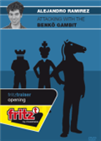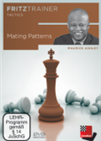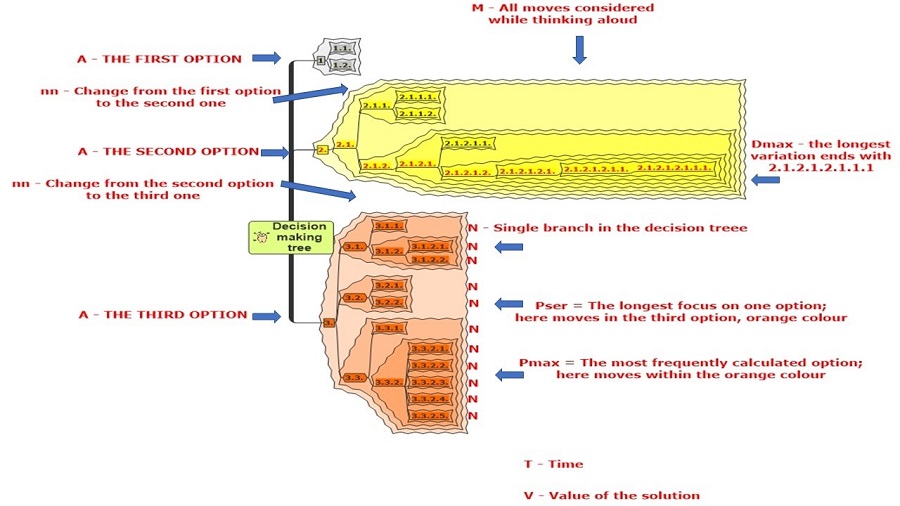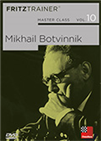Analytical improvement
We continue from Part 1, where the first three indicators were laid out:
M - the number of all considered moves
N - the total number of subsequent proposals to solve
A - the set of alternative actions (candidate moves) considered by the subject
Indicator Dmax
Dmax - denotes the maximum length of calculated variations, the measured number of white and black moves. This value reveals how far ahead the subject is able to calculate variations, to what extent he is able to or wishes to foresee events as they unfold on the chessboard. Dmax can be a measure of an individual's skill in imagining spatial relationships and manipulating them when thinking, or as with other factors, it could simply reflect the situation on the chessboard.
Possible questions:
- Did I predict the consequences far enough?
- How far am I able to foresee the possible consequences?
The positions that require deep-counting were a great pleasure for both myself and my subjects. We often discovered the great potential of the respondents. During the classes of the Youth Chess Academy I used quite a cruel position, presented below. But the leading juniors, in their calculations, reached quickly enough 15-18 moves variations!
Indicator nn
nn - denotes the overall total number of successive changes in the solving propositions. This value applies to all the proposals in the formula, but noted here is each instance of change, each new approach to the problem (including the very first letter as an instance of "change"). In the formula a-a-a-a-b-a the value of nn is 3, as the first four letter a's are treated as a single approach; while in our original example above nn = 11.
Possible questions:
Is my process of thinking structured in a good order?
Here is a task that can teach a certain level of order in thinking that Alexander Kotov (1971) wrote about:
Solution: In this position, Black had to check a few logical continuations:
A. Fight for the open line! 22...Rhd8 23.Rxd8 (23.Rg7+ Kf6 24.Rxa7 Nd3+=) 23...Nxa2+ 24.Kc2 Rxd8=;
B. Advance your strong pawn! 22...c3 23.Rd7+ (23.f6+ Kxf6 24.Ne4+ Kf5=) 23...Kf6 24.Ne4+ Ke5=;
C. Take a pawn! 22...exf5 23.Rg7+ (23.a3 Nd3+ 24.Nxd3 cxd3=) 23...Kf6 24.Rxa7 Ra8=;
D. Can you see a check — play it. Maybe it will be mate! 22...Nd3+.
But the fifth possibility, E, wins:
22...Rhc8!!
It was necessary to see 35 half-moves ahead!
(Replay the rest in the game viewer below!)
Indicator Pmax
 Don't give 1.d4 players an easy ride — sacrifice a pawn with 3.b5 for a lasting initiative. GM Ramirez shows you clear ideas for play in every variation.
Don't give 1.d4 players an easy ride — sacrifice a pawn with 3.b5 for a lasting initiative. GM Ramirez shows you clear ideas for play in every variation.Pmax - denotes the number of re-examined solving propositions. This value marks out all the proposals considered more than once, in other words, all the first moves (moves-candidates) appearing in the decision tree for the first, and later for the second, third time, etc.
The psychological significance of Pmax can vary. It may reflect a "functional fixation," when the subject is unable to break through certain barriers during the problem-solving process, and repeatedly directs attention towards the same moves "going round in circles." A high value of Pmax could also be evidence of a difficulty in making decisions.
Possible questions:
- Am I able to concentrate enough on the best option?
Sometimes the choice of certain positions informs the player or trainer whether he or she deals with the main and strongest option. There is a strong connection with the chunking theory, to be discussed shortly.
In the position below, White may concentrate on taking a pawn and calculate the consequences of 1.Qxe4. But there is another deep idea…
Solution:
White must concentrate on Zugzwangs! 1.Qc4+ Qb4 2.Qc6+ Qb5 3.Qxe4+ Qb4 4.Qd3 g6
Here are the main variations (replay in the game viewer below!):
Indicator Pser
Pser - denotes the number of times a solving proposition is reconsidered, but only in the longest single series. From a psychological point of view, this value represents the ability to concentrate on a single chosen solving proposition.
Possible questions:
- Am I able to concentrate enough on one option at one moment?
Many times, only one option requires great concentration and careful thinking. Let us have a look at the following ending
 Scarcely any world champion has managed to captivate chess lovers to the extent Carlsen has. The enormously talented Norwegian hasn't been systematically trained within the structures of a major chess-playing nation such as Russia, the Ukraine or China.
Scarcely any world champion has managed to captivate chess lovers to the extent Carlsen has. The enormously talented Norwegian hasn't been systematically trained within the structures of a major chess-playing nation such as Russia, the Ukraine or China.
White had to calculate the idea of reducing the material, what might be dangerous (draw!). So let us have a look at variations calculated by Carlsen, in order to avoid a draw.
Solution:
44.hxg6! fxg6 45.Rh1 Kf7?!
(Replay the rest in the game viewer below!)
The complete game with Carlsen's annotations:
Indicator T
T - denotes the time to solve the exercise. On the one hand, this can reflect the tested individual's superior problem-solving speed and can vary according to his/her cognitive style — reflective versus impulsive. On the other hand, the time to solve the task may simply be a function of the difficulty of the problem.
Possible questions:
- How much was my solving time really worth?
Of course, the most known task is the one presented below — mate in only one move. If you do not know this problem, have fun!
Solution:
Qa3! Mate!
How long did it take you to get the solution?
Indicator V
 On this DVD, Grandmaster and worldrenowned commentator Maurice Ashley reviews some of the most interesting patterns with examples meant to educate and entertain.
On this DVD, Grandmaster and worldrenowned commentator Maurice Ashley reviews some of the most interesting patterns with examples meant to educate and entertain. V - denotes the value of the solution, i.e. 1 or 0.
Possible questions:
- How much is my solution worth?
Here, of course, a million examples can be given. Let's choose something mysterious:
Are you sure your solution is correct?
Solution:
12.0-0? is a famous mistake (Black has compensation for the pawn). Only 12.Be3! gives White a clear edge, for example after 12…Bxe3 13.Qa4+! Nd7 14.Qxb4 Bc5 15.Qe4+ Kf8 16.0-0 b5 17.Nc2.
This novelty was prepared by World Champion Anatoly Karpov and used against J. van der Wiel, Brussels 1986.

Karpov and Kasparov in 1988 | Photo: Rob Bogaerts / Anefo [Public Domain] via Wikimedia Commons
And do not choose your wife or husband with this method, please. Follow your heart.
The indicators described above (M, N, A, Dmax, nn, Pmax, Pser, T, V) are summarised in Fig. 15.

Click or tap to expand
Chunking Theory
 Our experts show, using the games of Botvinnik, how to employ specific openings successfully, which model strategies are present in specific structures, how to find tactical solutions and rules for how to bring endings to a successful conclusion
Our experts show, using the games of Botvinnik, how to employ specific openings successfully, which model strategies are present in specific structures, how to find tactical solutions and rules for how to bring endings to a successful conclusionMikhail Botvinnik said:
Capablanca didn't make separate moves — he was creating a chess picture. Nobody could compare with him in this.
This is a smart introduction to the so-called "chunking theory".
A chunk is defined as a familiar collection of more elementary units that have been inter-associated and stored in memory repeatedly and act as a coherent, integrated group when retrieved (Tulving & Craik, 2000; Tulving, E., & Craik, F. I. M. (2000). The Oxford handbook of memory. Oxford: Oxford University Press).
"Chunks" are seen as an important basis for building mastery in chess!
For years, chess players trained typical positions, having in mind not only the structure on the chessboard, but also possible actions. Example: White may see this characteristic structure as some kind of "chunk": Qc4, Nh6, Kh8, Wc8, p. g7, p. h7:
Solution:
1.Qg8+! Rxg8 2.Nf7 mate.
The final position can be seen as another "chunk", but without actions attached to it:
Note that in our diagrams "chunk" sometimes means a pattern in which the pieces may be placed not exactly in the same position. In our example, the white queen may be placed on a2, b3, d5, e6 or f7. The idea is the same: checkmate after a sacrifice on g8.
Let us finish the idea of "chunking theory" with the famous "Loman's Motif":
Solution:
1... Rc3+ 2.Kf2 (2.Kg4? Rc4+ 3.Kg5 Rh4 4.Kxh4 g5+ 5.Kxg5 Kg7! -+) 2... Rc2+ 3.Ke1 Rc1+ (3... Rxg2 4. h8=Q+) (3... Rxg2 4. h8=Q+) 4.Kd2 1:0
Having in mind this idea we are able to solve the next task very quickly:
Solution:
1.Rxf5 Kxf5 2.g4+ Kf4 [2...Ke5 3.Kg2 Kd5 4.Kxf2 Kc5 5.Kf3 Kb5 6.Kf4 Kxa5 7.Kf5 Kb6 8.Kxf6] 3.Kg2 Ke3 4.Kf1 1-0
Checkmate. That's the aim of the game. There are numerous ways to checkmate the enemy king, but there are common patterns that recur over and over again, and having these at our mental fingertips is essential for when we want to finish the game.
And finally, you will solve the last task within a few seconds, having incorporated "a chunk" in your mind:
I wish you a successful combination of the two ideas while training: the "Chunking Theory" and the Nine Indicators in calculations.
References
- Chase, W. G., Simon, H. A. (1973). Perception in chess. Cognitive Psychology, 4, 55-81.
- De Groot, A. D. (1965). Thought and Choice in Chess. The Hague, Paris: Mouton & Co.
- De Groot, A. D. (1981). Thought and Choice in Chess: An Overview of a Study Based on Selzean Theory. W: N. Frijda, A.D. de Groot (red), Otto Selz: His Contribution to Psychology (192-255). Hague.
- Kotov, A. (1971). Think like a grandmaster. London: Batsford.
- Gobet, F. (2001). Chunk hierarchies and retrieval structures: Comments on Saariluoma and
- Laine. Scandinavian Journal of Psychology, 2001, 42, 149-155.
- Gobet, F., Clarkson, G. (2004). Chunks in expert memory: Evidence for the magical number four… or is it two? Memory, 2004, 12 (6), 732-747.
- Przewoznik, J. (2003, 2011). Mysl - Dzialaj - Zwyciezaj! Psychologia szachów w praktyce. Gorzów Wielkopolski: Integracja.
- Przewoznik, J., Soszynski, M. (2001). How to think in chess. Milford: Russell Enterprises, Inc.
- Ross, Ph. (2006). The Expert Mind. In: What Makes a Genius.
- Saariluoma, P. (2001). Chess and content-oriented psychology of thinking. Psichologica, 22, 143-164.
- Zlotnik, B. (ed., 1990). Shakhmaty. Nauka, opyt, masterstvo. Moscow: Vysshaia Shkola.

























